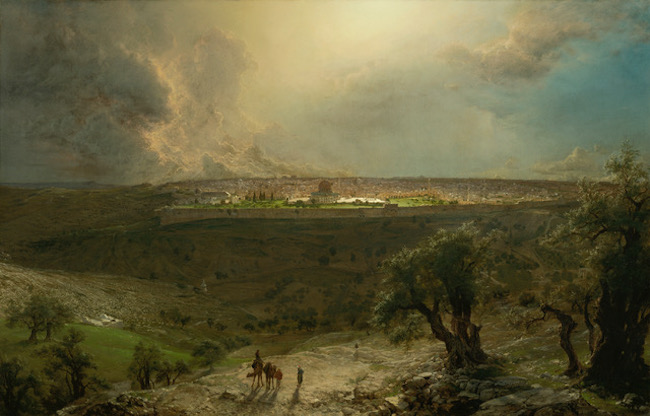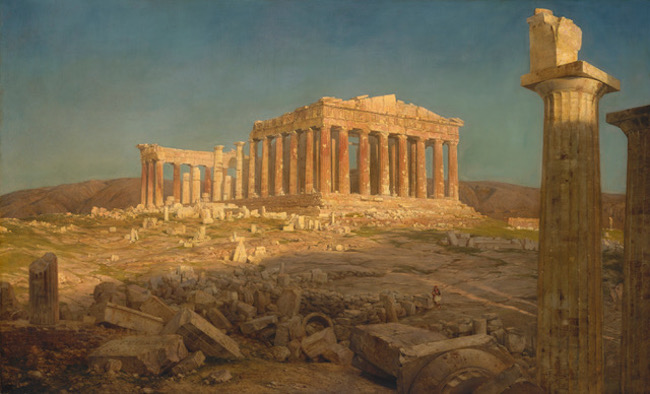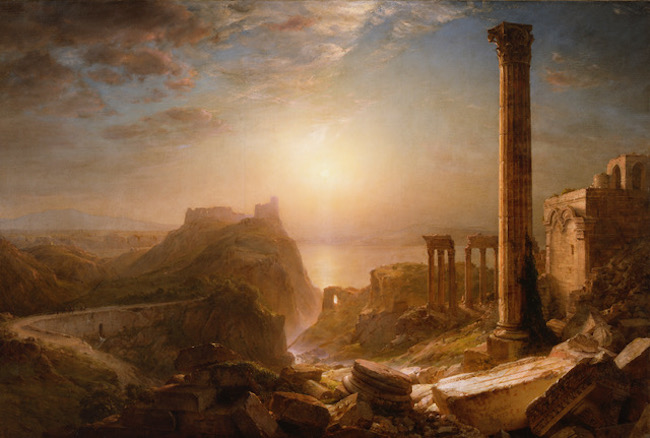Visual Arts Review: “Frederic Church — A Painter’s Pilgrimage”
To modern sensibilities, Frederic Edwin Church’s field sketches and early studies, with their virtuoso spontaneity and unmediated naturalism, may have more appeal than his epic paintings.

Frederic Edwin Church, “Jerusalem from the Mount of Olives,” 1870, oil on canvas. The Nelson-Atkins Museum of Art. Photo: courtesy of Wadsworth Atheneum Museum of Art.
By Peter Walsh
The Wadsworth Atheneum’s exhibition Frederic Church: A Painter’s Pilgrimage (through August 26) opens with Church’s monumental painting “Reverend Thomas Hooker and Company Journeying through the Wilderness from Plymouth to Hartford in 1636“ (1846). In this image of Hartford’s founding legend, Rev. Hooker and his small band of Puritans pioneers, which included Church’s own direct ancestor, Richard Church, cross a hillside stream, overwhelmed by a vast, wild landscape: a vision of tiers of cliffs, waterfalls, forests, and light-touched still water stretching to hazy hills, over which the sun is about to set in a cloudless blue sky. Apart from the English settlers, their horses and cows, and a dog, there is not a sign of civilization, no hilltop castles or forts, no broken aquaducts, no ruined temples, no country mansions, no picturesque farms or villages and no trace of native inhabitants or even of the Dutch settlers who had reached the site of Hartford from New Amsterdam some years earlier.
This is not only terra incognito but virgin territory. The label copy next to the painting mentions the traditional Christian subject of the Flight into Egypt. But the symbolic content is richer. It embraces the idea of the Americas as a new, unspoiled Garden of Eden, the legend of the limitless Western frontier, and the growing strength of American Exceptionalism.
But Church, a member of the “second generation” Hudson River School and one of the leading and most successful painters of the early 19th-century, had another side, the true subject of the exhibition. Proud as they were of their break with the European past, Americans were also painfully aware of their arriviste status and their lack of a deep, recorded history and its monumental remains. Some even created mythical histories for the new continent, claiming the Native Americans were descendants of the Lost Tribes of Israel, for example, or that Vikings had settled on the shores of New England centuries before Columbus . Others, seeking a richer cultural setting, simply moved, with their new American fortunes, back to the Old World. Church, a member of a wealthy and well-established Hartford family, eventually decided to make the pilgrimage himself.

Frederic Edwin Church, “The Parthenon,” 1871, oil on canvas. The Metropolitan Museum of Art. Photo: courtesy of Wadsworth Atheneum Museum of Art.
In 1867, Church, who had made a name for himself with tour-de-force views of North and South Amierca, embarked on a long working tour of Europe and the Middle East. Syria, the mysterious rock tombs of Petra, Jerusalem, Athens, and Rome crowded his itinerary. A bit late to the track—- the English Romantics had made the trip two or three generations earlier— Church found the trip productive and a source of influence for the rest of the artist’s life.
Church’s working methods were traditional, borrowed from the Old Masters. He made sketches — drawings, watercolors, or quick oil studies — in the field or not long after and worked the material, some times years later, in his studio to create the huge, intricately detailed canvases his wealthy patrons demanded. These works appealed to nation-building men, like fellow Hartford native J. Pierpont Morgan, who not only built business empires but saw themselves as weaving the national culture from homespun yarn. These paintings were epic efforts, designed to impress — in public exhibitions or Manhattan drawing rooms. Their symbolic underpinnings, with their strains of Progressive Christianity and a rapturous brand of Romanticism, were suitably unambiguous. But, to modern sensibilities, Church’s field sketches and early studies, with their virtuoso spontaneity and unmediated naturalism, may have more appeal. The Wadsworth exhibition hangs both side by side, making the comparison an easy one.
In “Jerusalem from the Mount of Olives” (1870), for example, Church depicts the Holy City from a famously iconic vantage point: centered on the Temple Mount, caught in a momentary bolt of heavenly light, tempestuous clouds massing above. It is conceived on such a scale and in such detail that it can be contemplated like an actual view of the place, much as it might be seen by the small figures in the foreground. In an 1868 study next to the painting, though, the Temple Mount is off to the right and the entire city almost disappears in the desert haze. This version centers on a dark, solitary, ambiguous figure in the middle ground — a stroke or two of black against a vivid, vernal patch of green — perhaps a pilgrim, perhaps an Arab farmer who is heading for the olive grove on the left, indifferent to the historic panorama before him.
Similarly, in the fully-developed version of “The Parthenon” (1871), Church uses the familiarly post card view of the ravaged temple, its pock-marked columns gilded by the afternoon light, rising magnificently above the ruins of the Acropolis. In studies from 1868 and 1869, Church shows the building from a much greater distance, diminished to a battered, almost pathetic relic and surrounded by fields of ancient rubble and the rough Attic hills.

Frederic Edwin Church, Syria by the Sea, 1873, oil on canvas. Detroit Institute of Arts. Photo: courtesy of Wadsworth Atheneum Museum of Art.
In adjoining galleries, the exhibition explores the aftermaths of Church’s adventures. In works like “Syria by the Sea” (1873) the artist moves into Romantic fantasies of broken columns, sunsets over the ocean, evoking the kind of nostalgic light movie makers call “the magic hour.” By this time, the French Impressionists were working and exhibiting around Paris and drawing American fans. Church’s work, for all its late Victorian appeal, had begun to look old fashioned. At the time of his death in 1900, with his admirers grown old or deceased, the frontier conquered, and the national myths being revamped for the “American Century,” Church seemed to belong to a vanished Age of Innocence. Along with the work of many of his contemporaries, Church’s paintings found their way into dusty back parlors, attics, and storage rooms, where they slept for decades.
A final section of the show is devoted to Olana, the magnificent country estate Church began to compose in the Hudson Valley, not long after he returned from overseas. The house and its carefully designed grounds have been described as Church’s “masterpiece” and their creation encompassed most of the rest of his time on earth.
In this sprawling estate, the two sides of Church’s sensibilities finally joined: his love of the exotic east in the decorative motifs and furnishings of the house, an exuberant blend of Moorish, Persian, and Middle Eastern motifs, and his devotion to the great American landscape, in the carefully arranged, breathtaking views over meadows and woodlands to the great Hudson River winding below.
Remarkably, Olana remained in the hands of Church’s family for more than sixty years after he died. It was nearly perfectly intact, including its original furnishings and dozens of Church’s own paintings when, in the ’60s, a public sale threatened its dispersion forever. An eleventh-hour effort by a handful of scholars and Church enthusiasts saved the place. A long process of preservation and restoration followed. Later, the moment seems to have been a turning point in the reassessment of the entire Hudson River School. Once again, Church stands at its head.
Peter Walsh has worked as a staff member or consultant to such museums as the Harvard Art Museums, the Museum of Fine Arts, Boston, the Davis Museum at Wellesley College, The Metropolitan Museum of Art, the National Gallery of Art, and the Boston Athenaeum. As an art historian and media scholar, he has lectured in Boston, New York, Chicago, Toronto, San Francisco, London, and Milan, among other cities and has presented papers at MIT eight times. He has published in American and European newspapers, journals, and in anthologies. In recent years, he began a career as an actor and has since worked on more than eighty projects, including theater, national television, and such award-winning films as Spotlight, The Second Life, and Brute Sanity. He is a graduate of Oberlin College and Harvard University.

It might be helpful to give people an address for the Wadsworth Antheneum of Art. That way one can see right away what a visit would entail. Thanks.
There is a link to the museum — and information about the exhibit — in the piece.
Nicely written review. Descriptive of the work, with interesting social and art historical context.